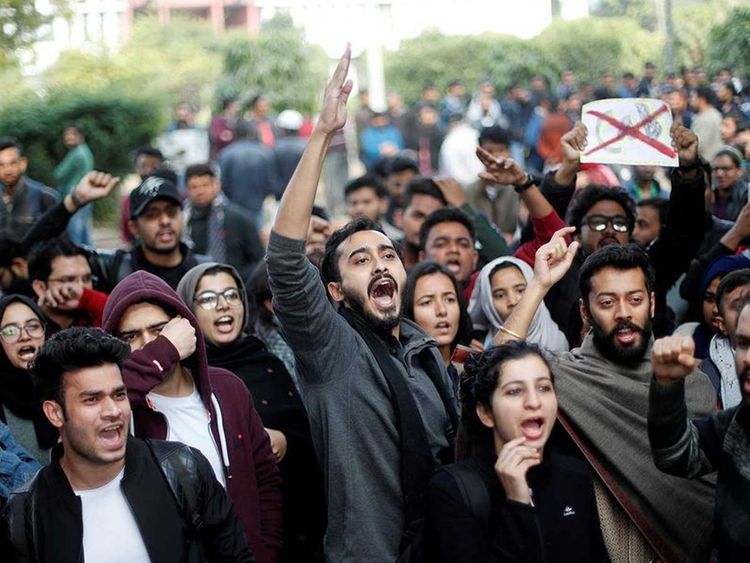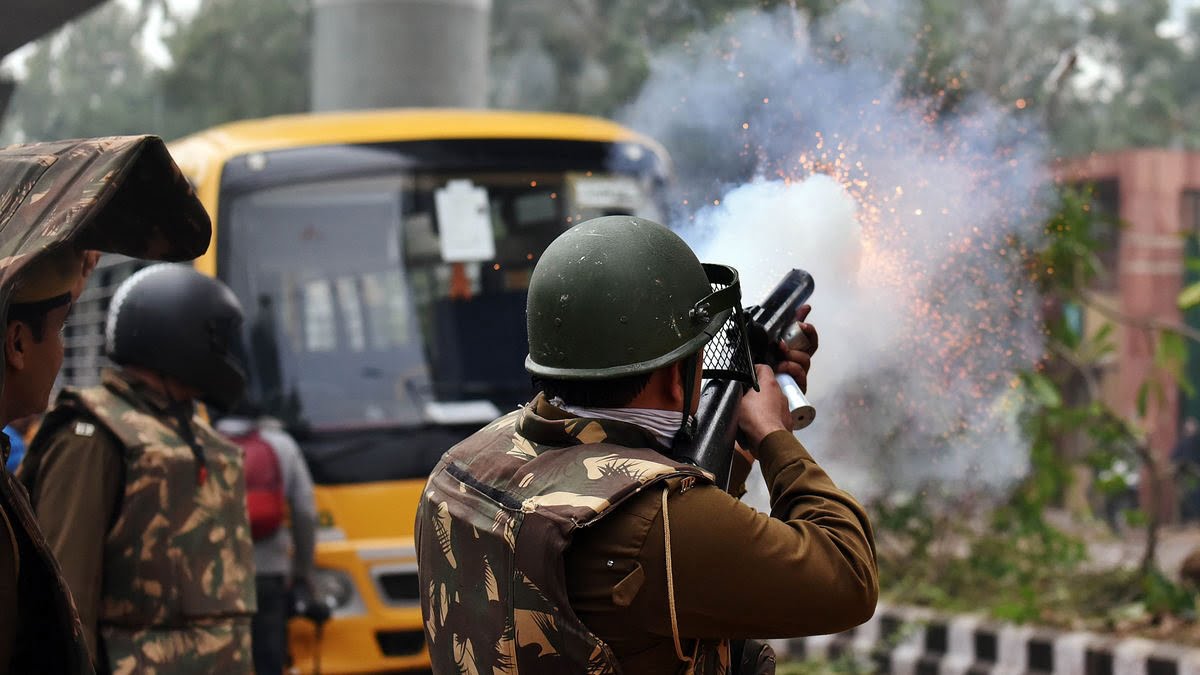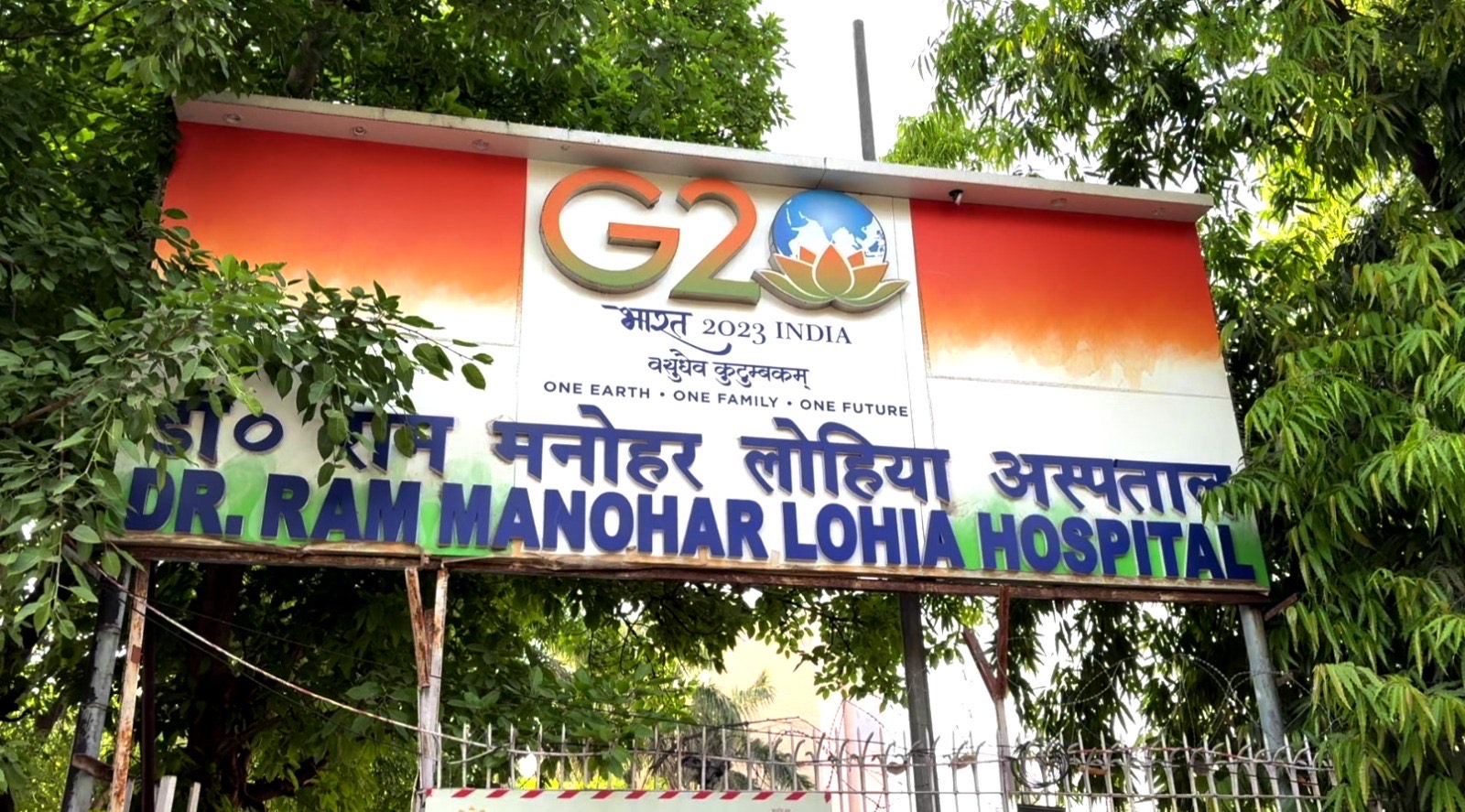“I still get nightmares of the day,” said Tanya*, a law student at Jamia Millia Islamia, recounting the tear gas attack on a moving protest she was part of. Tanya has a family medical history of asthma which worsened when she was exposed to the chemical weapon.
“On 15 December, we were on the Mata Mandir road as part of a silent protest demonstration organised by our department. That is when we saw the policemen charging towards us. Not only did they lathi-charge the students, they also began firing tear gas shells in our direction within barely a distance of five metres,” she said. Tanya found that her period cycle was delayed by 20 days that month.

In December 2019, the country witnessed one of the most horrifying episodes of police brutality on the students of Jamia and Aligarh Muslim University protesting the implementation of the draconian CAA/NRC. The Delhi Police had reportedly used about 75 tear gas shells, some of them even expired, to disperse the protests.
22-year-old Taslima* got caught in the violent attacks on Jamia students that unfolded on 13th December and 15th December. She was exposed to tear gas at a close range on both days. “That month, I remember getting painful cramps around the time my cycle was supposed to begin on several days as if I was going to start bleeding any time now. But this went on for at least 8-10 days before my period cycle finally started,” she said.
Taslima asserts that she would usually get her period a day or two before the actual date and this was the first time that her period was delayed by more than a week.
Also read: Who Turned The Peaceful Protests Violent In Jamia Millia Islamia University?
22-year-old Taslima* got caught in the violent attacks on Jamia students that unfolded on 13 December and 15 December. She was exposed to tear gas at a close range on both days. “That month, I remember getting painful cramps around the time my cycle was supposed to begin on several days, as if I was going to start bleeding any time now. But this went on for at least 8-10 days before my period finally started,” she said.

Similar experiences were shared by protesters at Black Lives Matter protest demonstrations, leading to a snowball effect on social media with more people discussing similar experiences citing instances of abnormal menstrual bleeding, delayed cycle, heavy flow and severe painful cramps. They all traced it back to one common factor–exposure to tear gas attacks. Yet, there continues to be a lack of research on the effects of the widely used chemical weapon on menstruating bodies.
In this report, Feminism In India got in touch with anti-CAA/NRC protestors from Jamia and Black Lives Matter demonstrations whose menstrual cycles were tangibly affected after getting exposed to tear gas.
Delayed and Painful Period: Students of Jamia Millia Islamia
Taslima, pursuing MA in Convergent Journalism from Jamia, was reporting for the University paper on the police attack on December 13. “I was in between gate number 5 and gate number 8 when a tear gas shell was thrown in our direction. Since I was experiencing something of this nature for the first time, I immediately went in and washed my face, which only made it worse,” she said. According to a 2018 report, water initially exacerbates the effects of tear gas. On December 15, she found herself in the middle of a tear gas attack again, this time when she was right outside the central library area looking for her two friends who had gone missing in the frenzy.
20-year-old Shreya*, a student of the English department at Jamia, was also exposed to tear gas on 13 December. She said her period would usually be non-painful and last for three days. But following the attack, she missed her cycle in December and got a week-long, painful period in January.
“This was the first time I was facing a situation so stressful and I naturally thought my period was delayed because of the same,” Tanya said. Taslima and Shreya too had thought the same.
Also read: Beyond Barricades: Police Violence Against Women In Jamia Protests
Multiple Periods In A Month And Body Dysphoria: Black Lives Matter Protester
Charlie* is a 33-year-old Black queer and trans person identifying as gender non-conforming. They were protesting downtown in Columbus, Ohio during the last week of May and the first week of June for multiple days demanding an end to police brutality. Within that time period, they were exposed to tear gas over 15 times.
“I remember being exposed 5 times on May 30th during the day and at night. Police would intentionally throw canisters in multiple directions so that anywhere you walked you would be exposed or would throw a canister in the direction they would force you to walk. I had just ended my period right before the uprisings, so I knew something was off when my period began again after 30 May,” they said. Coupled with unusually painful cramps, Charlie has had about five periods with more and more time in between them since the uprisings.
This had tangible effects on their mental health as well. “Your period makes your breasts sore which reminds me that I have them, thus heightening my dysphoria. The severe cramps remind me I have ovaries, which makes me have to sit still and rest while my other comrades are out protesting,” they said.
When they shared their experience on social media, others spoke up too. “People were experiencing multiple, extremely painful periods—all having only occurred after tear gas exposure. We also saw some people miscarried which we know through research as a known side effect of tear gas exposure.“
When Charlie shared their experience on social media, others spoke up too. “People were experiencing multiple, extremely painful periods- all having only occurred after tear gas exposure. We also saw some people miscarried which we know through research as a known side effect of tear gas exposure.”

Charlie’s attempts to understand better what was happening to their body led them to Dr Alexander Samuel who has been researching the impact of tear gas exposure on the body. Dr Samuel is a 35-year-old PhD holder in molecular biology of brain development.
Lack Of Research
Involved in the Yellow Vests movement and related mass demonstrations in France, Dr Samuel began investigating tear gas impacts to disprove the paranoid protesters and victim associations telling him that the “government is hiding cyanide (in tear gas) and killing us all”. However, when he saw that the effects the protesters faced were dizziness, loss of consciousness, loss of memory, and impaired menstrual cycle–all that are not usually related to tear gas exposure, he was concerned.
He found that tear gas metabolised into cyanide in animal tissues, which was theoretically assumed as low in content when produced. “However along with three physicians, I measured high cyanide levels in some protesters’ blood just after tear gas exposure. Sadly, an investigation was started by the French police for ‘aggravated violence’ and ‘endangering people’s life’ based on this blood uptake which we had done with the written consent of all patients, thus stalling the research. Nothing was done about cyanide poisoning meanwhile,” he said in an email interview to Feminism In India.
Dr Samuel said that some of the Yellow Vests demonstrators reported heavy menstrual bleeding just after tear gas exposure, while others had impaired and delayed menstrual cycles. Women who had become menopausal experienced menorrhoea again, and some even complained about their intrauterine device (IUD) “melting”, he said. “One of the hypotheses floated was that the tear gas is affecting the endocrine system, changing hormone levels and affecting periods. However, hypoxia (deficiency in oxygen reaching tissues) which is a consequence of cyanide poisoning, has been described as triggering heavy menstrual bleeding. I think this hypothesis of cyanide could be causing the menstrual cycle impairment,” he added.
In an email interview with Feminism In India, Dr Satyanarayana Achanta, Assistant Professor at the Department of Anesthesiology at the Duke University School of Medicine, is of the opinion that CS tear gas could potentially cause hormonal imbalance in protesters. “Limited studies conducted on animals suggested histological changes in adrenal glands and thyroid glands–both of which impact the secretion of and balance in the sex hormones,” he said.
He stated that other than a few media reports that suggested heavy bleeding during menstrual periods, delayed bleeding or spontaneous onset of periods after exposure to CS tear gas agents, no prospective studies were conducted on the effects of CS tear gas agents on menstrual cycles or the endocrine system.
CS gas or 2-chlorobenzalmalonitrile is the most commonly used tear gas in the world.
“During the protests, there will be stress, anxiety, and exhaustion that may add to the effects of CS tear gas injuries leading to miscarriages. Nevertheless, without scientific evidence, it is difficult to establish this fact,” he concluded.
Speaking to Feminism In India, Dr Rinku Sengupta, obstetrician and gynaecologist at Sitaram Bhartia Institute of Science and Research, that stress and anxiety experienced during protests could affect one’s brain, interfering with the hormones that regulate menstrual cycles.
Also read: Women Students Return To Jamia Millia Islamia Ready To Rage
An Assumption Of Public Spaces As Gendered
Sven-Eric Jordt, an associate professor of anesthesiology at Duke University, wrote on how there was a higher than usual number of miscarriages in pregnant women, “probably due to shock and stress and the chemical exposure” after tear gas attacks.

Movements of resistance over time have seen more and more women reclaiming the streets while protesting for their rights. The continual use, despite evidence that tear gas could lead to abortions and result in abnormal menstrual bleeding, not only shows state structures’ emphasis on incarceration but also the assumption that movements of resistance are mostly populated by men. This adds to the archaic discourse assuming that women are relegated to the private.
The continual use, despite evidence that tear gas could lead to abortions and result in abnormal menstrual bleeding, not only shows state structures’ emphasis on incarceration, but also the assumption that movements of resistance are mostly populated by men. This adds to the archaic discourse assuming that women are relegated to the private.
If the purpose of using tear gas is to disperse crowds then why should one set of the protesting population also deal with repercussions on their menstrual and reproductive health? While it could be argued that most times, the effect on the protesters’ menstrual cycles is a temporary one, the irregularities also lead to an increased mental and emotional upheaval for those affected and for those like Charlie, even worsening their body dysphoria, all because a chemical weapon banned in war continues to be used with no limitations by the police and the State.
*Names have been changed to protect the identity.
Featured Image Source: ThePrint
About the author(s)
Soumya is a Masters graduate in gender from Jamia Millia Islamia & has a PG Diploma in New Media from Asian College Of Journalism. She is learning to unlearn and question patriarchal structures with empathy. She has taken an interest in gardening but has over-watered and killed two plants already. This may or may not be a metaphorical reference to how she deals with life.




